|
Mazda 6 / Atenza
Debut: 2008
Maker: Mazda
Predecessor: Mazda 6 Mk1 / Atenza
|
|
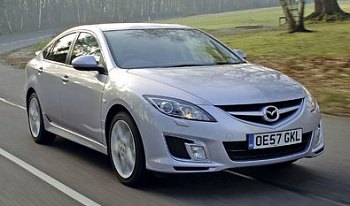
|
Driver appeal distinguishes the old 6
from rivals. Now it is going to take the success even further...
|
Ask
what Mazda was a decade ago, you might recall a dull product portfolio
consisting of 323, 626, Demio, Millenia etc. Yes, apart from the niche
MX-5 and RX-7, Mazda was hardly renowned for driver appeal. So what
changed its image by 180 degrees ? That was the first generation
Mazda 6. The Mazda 6 surprised people by its great handling, firm
ride and sharp steering. It converted Mazda into a driver-oriented
brand and won 1.3 million sales worldwide, among which some 450,000
units went to the driver appeal-demanding European market. This was
unusual for a Japanese car indeed. Now the second generation aims to
take this success even further.
Although the new Mazda 6 breaks no new ground in automotive design, it
is a handsome car nonetheless. A sleek profile combines with crisp
lines and sharp headlights to form a modern and sporty appearance. Cd
has been lowered from 0.30 to a remarkable 0.27, which should aid fuel
economy and top speed. The inverted triangular grille is a signature of
the old car, while the pronounced front fenders have strong resemblance
to RX-8. My only criticism is about the details - for example, the
various bumper intakes could have been arranged more elegantly. These
flaws could hurt its long-term visual durability, if not showroom
appeal.
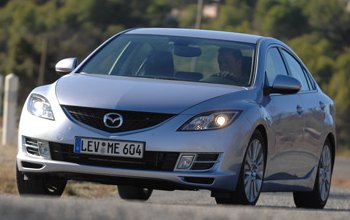
|
Though breaking no new ground in
design, it is a handsome car nonetheless...
|
Unlike
many people's believes, the new 6 is not derived from Ford Mondeo's
EUCD platform but the old Mazda 6 platform. It grows in all dimensions
- 65 mm longer, 15 mm wider, 5 mm taller and 50 mm longer wheelbase -
but is still compact by class standard. It is smaller than Volkswagen
Passat, let alone the oversize Mondeo. Brilliantly, by using more
high-strength steel in the chassis and by trimming unnecessary weight
from all kinds of components, it achieves greater chassis rigidity,
better crash protection and simultaneously a reduction of 35 kg of kerb
weight in average. Torsional rigidity of the 4-door sedan is increased
by 14 percent, while 5-door hatchback even gains 30 percent. These
factors translate to better handling, refinement, performance and fuel
consumption. Another good job after Mazda 2.
The chassis still rides on double-wishbone suspensions up front and
multi-link suspensions at the back, which is already the best
configuration today. The front suspension subframe has 6 mounting
points instead of 4 and softer bushings to reduce NVH transmitted to
the chassis. Other sound deadening improvements contribute to a
reduction of 2.5dB (or 45 percent) road noise to the cabin. Mazda
proves that clever engineering can reduce weight and NVH
simultaneously. Take note, Mondeo. The rear suspensions' trailing links
have their front pivots positioned higher to reduce tail lift under
braking, while the dampers are mounted more upright to improve
responsiveness.
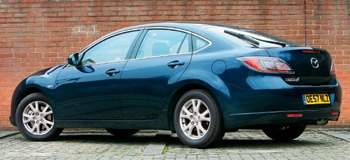
|
Longer, wider and taller than its
predecessor, the new car managed to be 35 kg lighter. Brilliant !
|
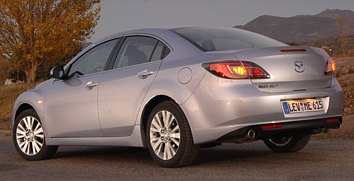
|
4-door sedan (shown here) is expected
to sell better in Japan, while 5-door hatchback is the star in Europe...
|
On the road,
the
Mazda 6 continues to delight keen drivers. Its lightweight and compact
size means it is more nimble in the twisty than Ford Mondeo -
currently our class leader in dynamics and overall. Its firm and
controlled ride, fine body control, excellent grip, powerful brakes and
good resistance to understeer put smile on the driver face. Even its
electrical power steering seems to be the most sensibly weighted and
feelsome of its kind. This is the most engaging drive in the class.
However, in terms of refinement it still trails Ford Mondeo a little,
blame to the pronounced wind noise generated by the door mirrors. The
Mazda also has a firmer ride than the Ford, thus its occupants are
subjected to more shocks and road noise over coarse surfaces.
Otherwise, it is nonetheless a refined ride by class standard.
In terms of engine and performance, the Mazda 6 is competitive enough.
4 engines are offered at launch: 120hp 1.8-liter, 147hp 2.0-liter VVT,
170hp 2.5-liter VVT twin-balancer shafts and 140hp 2.0-liter 16V
common-rail turbo diesel. In particular, the 2.5-liter four-pot is a
bored and stroked version of the former 2.3-liter unit. It gets lighter
pistons, con-rods and a dual-mass flywheel to reduce vibration. It
enjoys a slight power and torque boost while consuming 6 percent less
fuel. On the road the 2.5-liter is smooth but less potent than
expected, so you need to use the slick 6-speed gearbox to extract
performance from it. By doing so, 0-60 mph can be done in 7.9 seconds.
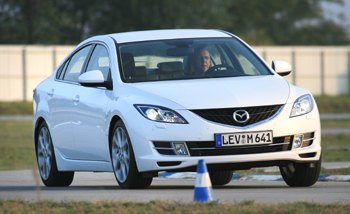
|
Lightweight and compact size gives it
decisive advantages in corners...
|
Inside,
the cabin of new Mazda 6 neither thrills nor disappoints. Its design is
conventional and initiative, with some classy details like the orange
and blue back-lit dials and steering wheel-mounted controls for audio,
sat nav and air con. On the downside, it does not feel as high quality
as Passat, Mondeo or Laguna, blame to the hard plastics used at various
places and the feel of weight savings throughout the cabin. Although
there is more rear legroom and shoulder than the old car, its rear
headroom is limited by the sloping rear window. Access to the rear
cabin is also made difficult by the sharp-angle C-pillars. This mean
6-footers will be better served in its rivals.
Overall, Mazda 6 edges out Ford Mondeo as the best driver's car of the
mid-size family car segment. However, if comfort, refinement and
quality are equally important to you, the result will be reversed.
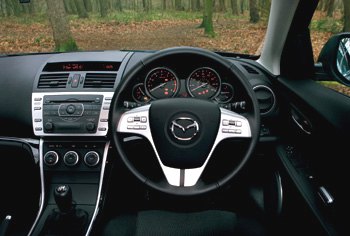
|
What Mazda 6 loses out to others is
the cabin - cramped at the rear and short of visual desirability up
front...
|
|
| The
above report was last updated on 20 Jan
2008. All Rights Reserved. |
Mazda 6 (America)
|

|
Size matters in the USA, so Mazda has
supersized its 6.
|
The
last generation Mazda 6 was not very successful in the USA market
because by American standard it was too small. All its main competitors
- Honda Accord, Toyota Camry, Nissan Altima and Hyundai Sonata - are a
size larger. Therefore this time Mazda specially designed the American
version to be larger. From these pictures you might not see the
differences, because it has successfully retained the
handsome design of the world version. But tape measure will find the
American version some 185mm longer, 45mm wider and 65mm longer in
wheelbase. With the same powertrain combo, it is around 120 kg heavier
than the world version.
The weight penalty paid off in cabin space. Now 6-footers can finally
rest comfortably behind two 6-footers. It matches Honda Accord and
Toyota Camry for cabin room while eclipsing them in truck space.
Despite of the much larger sheet metal, the cabin employs the same
dashboard and console design as the world version. That means it
appears to be much higher quality than the old car and matches that of
its rivals in North America, if not the high standard of European
sedans. Like the exterior, the clean and sporty design of the interior
could lure buyers from the camp of Accord, Camry and Altima.

|
It can easily beat Accord and Altima
for driving fun, thanks to better balance, better steering, better
damping and, well, just everything.
|
Despite
of the bigger and heftier body, the American car has retained much of
the keen handling of the world version. It can easily beat Accord and
Altima for driving fun, thanks to better balance, better steering,
better damping and, well, just everything. The new powertrains are also
up to the job - the base engine is the familiar MZR 2.5-liter
four-cylinder with 170 horsepower. Mated with a slick 6-speed manual
box, it has just the right punch to pull the 1.5-ton car. Above that is
a new 3.7-liter V6 (from CX-9 crossover) and 6-speed Aisin automatic
gearbox. The V6 is a bored-out version of Ford Taurus' 3.5-liter
Duratec. It pumps out 272 horsepower and 269 lb-ft of torque, a huge
improvement from the old car's 3.0-liter Duratec. With this engine,
Mazda 6 should produce competitive performance figures. The only
downside is a higher fuel consumption than its rivals' V6s.
With a stylish look, roomy interior, competent engines and
class-leading handling, the American Mazda 6 is easily the best family
saloon in the North American market. Ultimately, it is neither as agile
nor as eco-friendly as the world version, but those compromises are
nothing to American. |
| The
above report was last updated on 31 May
2008. All Rights Reserved. |
|
|